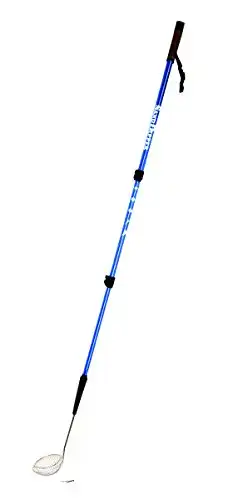Over the last 20 years, sea glass has gained increased popularity with beach-combers around the world. Sometimes called sea gems, mermaid tears, drift glass, or sea pearls, sea glass is becoming rarer and rarer, thus more and more desirable among dedicated collectors.
In a process quite the opposite of diamonds, which are created by nature and then collected and cut by man, sea glass is initially created by people, then left to nature to be polished and prepared for human collection and enjoyment.
If you’ve never heard of sea glass, it’s a little piece of collectible history worth reading about. It’s a bit of hope as well, as these colorful pieces are one example of how the earth can sometimes transform man’s neglect into a thing of beauty.
Read More:
- How To Find Sea Glass (10 Tips For Collecting Sea Glass)
- 9 Different Things To Do With Sea Glass! (How To Display Sea Glass)
- 10 Best Sea Glass Beaches on The East Coast
How is Sea Glass Formed?
Before preserving the earth’s environment became a priority, people living along beaches would often bury their trash in the sand or simply toss it in the sea, which seemed so huge it could absorb anything without being affected. The habit of ships carrying either passengers or cargo was to throw their refuse overboard for easy disposal.
A part of all this waste has always been broken glass, whether from alcoholic beverages, medicine bottles, chemical containers, preserved food containers, ink, or shattered dishware. All these varieties and colors of glassware sank to the depths, into a kind of natural tumbler that smoothed edges and added a frosted appearance to each piece.
Eventually, these pieces began to wash up on beaches around the world, in some locations in great numbers as the tides push them along. And so today sea glass is found along many coastal beaches, especially during low tide or after storms.
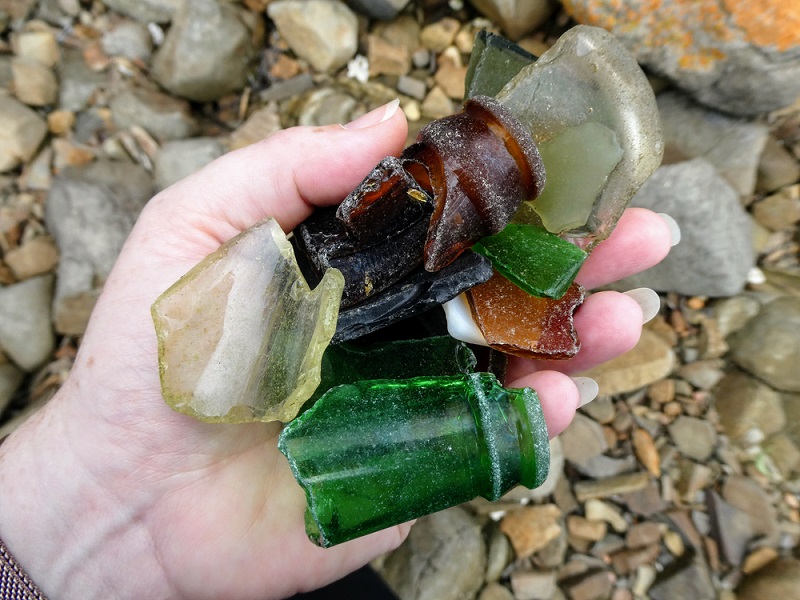
Sea glass comes in many sizes and shapes. These include frosty glass marbles or bubbles, which are perfectly round. Sea glass “rounds,” formed from the bottom of bottles, may still retain some embossed pattern identifying their origins, and campfire glass has been melted before being discarded and worn smooth in the ocean. Larger lumps are sometimes called boulders, There can also be stoppers from bottles or remnants of ship ballast.
All of these unique shapes and varieties have been produced by the relentless movement of the tides along the ocean floor and sandy, shallower land shelves just offshore which are continually beaten by incoming surf. The pieces and shards are tumbled over and over until they have each acquired a unique shape, smooth and safe for collectors of all ages.
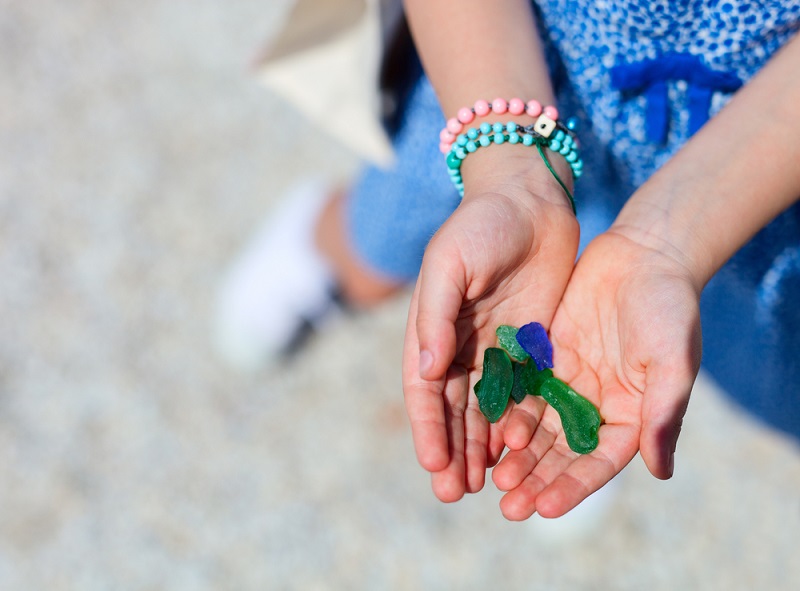
How Long Does It Take for Glass to Become Sea Glass?
Most sea glass takes 20-50 years to acquire its individual shape and frosted surface, but some tumble for up to 100 years before being permanently beached. Some pieces may be washed ashore after only about 10 years of tumbling in a constant surf environment.
A quality piece of sea glass will be completely smooth, with no shiny spots. The longer the glass has been tumbled, the greater the chance it will be completely transformed into a jewelry-quality piece. The physical and chemical weathering required takes time, and there’s just no substitute for it.
Most sea glass can be dated from the early 19th century on, but there are examples from centuries earlier that continue to wash up in the Caribbean Islands, California Beaches, and other beaches where tides push along the remnants of ancient shipping lanes.
Where Is Sea Glass Most Commonly Found
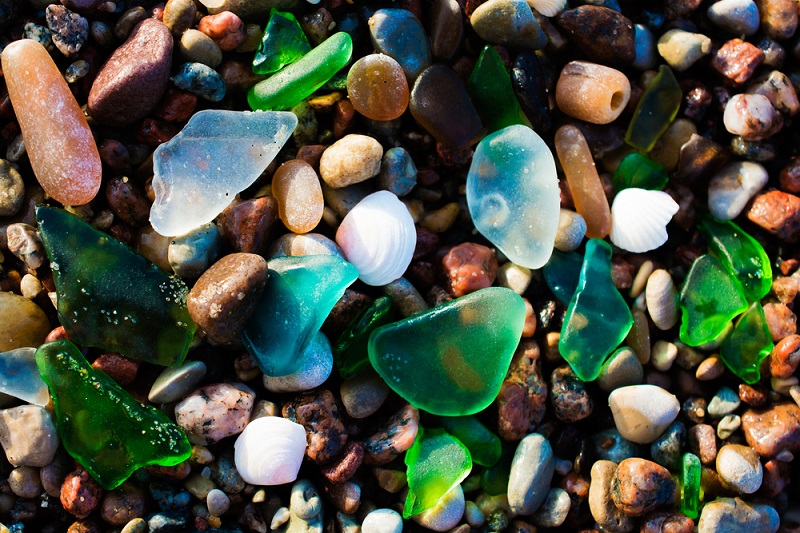
Although sea glass may be found along beaches all over the world, some areas are especially prolific. In the United States Hawaiian, northeastern, and some California beaches are well-known for consistent, quality finds.
Across the globe, Bermuda, Puerto Rico, Dominican Republic, Mexico, Scotland, the Isle of Man, Nova Scotia, Australia, Italy, and southern Spain all have popular collecting sites. Some of these areas are famous for particular types of sea glass. Here are some of the more frequented spots, though there are many more. Some have a great variety of colors, others may include rarer finds.
- Fort Bragg Sea Glass Beach, CA
- Kauai Sea Glass Beach, Hawaii
- Abaco Islands, Bahama
- Vladivostok, Russia–porcelain, glass from old vodka bottles
- Ireland Island, Bermuda
- Seaham, England–uranium glass
- Okinawa Island, Japan–reds, purples, and yellows
- Barcelona, Spain–some rare blacks can be found here
- Rincon, Puerto Rico–green, white, blue
- Essaouira, Morocco-various colors and old tiles
There are some beaches where the sea glass is so highly prized that collecting is prohibited. It’s also good to be aware that some locations revere the historical nature of the glass and consider gathering old items as a kind of cultural theft. In other areas, sea glass is thought of as just more trash washing up on the shore.
Note: Keep in mind that in the same areas where you find sea glass, you may also find:
- Polished bits of shells
- Hag stones
- Sea polished agate or jasper
- Other interesting specimens
What Is the Difference Between Sea Glass and Beach Glass?
Some collectors may be especially sensitive to the difference between sea glass and what is called beach glass. Others may consider the terms interchangeable. The main difference between the two is the source.
Sea glass is only collected from salt-water shores. Saltwater causes a chemical transformation that leaches out soda and lime used in the glass making process. This process, called hydration, results in a more frosted appearance and some pitting on the glass surface.
Beach glass is found on the freshwater beaches of lakes and rivers or river estuaries. This glass has a different pH balance and is less frosted than sea glass. Beach glass is found in many areas along the shores of the Great Lakes in the U.S. and collectors and craft hobbyists have helped to increase its local popularity.
Both sea glass and beach glass can be valuable, depending on several factors such as age, color, and patina. Aside from monetary worth, the glass is valued for its historical nuances and innate beauty.
This tool isn't for everyone. I'm listing it here for those who just aren't able to reach down and pick things up off the ground as easy as before. So, if you spend much time beachcombing, then you'll want to give this one a try. It's well worth it.
- Great for those with trouble bending down to pick up items.
- Access Hard To Reach Spots
- Stay Dry
- Doubles as a Walking Stick
How Can You Tell If Sea Glass Is Real?
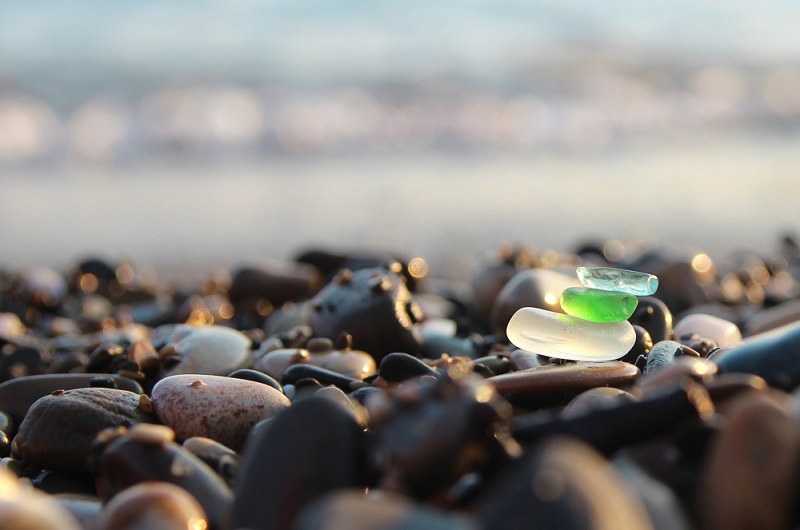
Because of an exponential increase in popularity, authentic sea glass is becoming rarer even as the marketing demand has been increasing. Not surprisingly, substitutes have become common among various glass artisans.
Artificial sea glass can be made in several ways. Poorer pieces of genuine sea glass may be tumbled in order to remove any remaining shiny areas or rough edges. This results in a replica called “twice-tossed” glass.
Or “craft glass” can be created with a rock tumbler and any ordinary glass. This glass can be acquired at lower prices in colors not found in authentic sea glass. Craft glass’s easy and economical availability makes it appealing to crafters, especially for mosaic-style art.
There are several marked, observable differences between genuine and artificial sea glass. Artificial sea glass may be chunkier or be available in uniformly shaped pieces. Authentic sea glass rarely repeats a shape or size, especially of the same type and color.
Also, it is almost impossible to replicate the patina of naturally tumbled, authentic sea glass. The pieces will have a highly frosted, almost powdery appearance with pitting from long exposure to saltwater.
Many authentic pieces also have a “C” shaped abrasion design all over them not found on artificially tumbled glass. This design may only be visible under a microscope, but is a clear indicator for collectors concerned about authenticity.
A few other indicators to look for are curvature from the natural shape of bottles or other types of discarded glass, and bubbles that would naturally occur in older glass-making processes.
If you are considering purchasing products made from sea glass, the price can be another indicator of authenticity. Pieces that claim to made from rare colors but are being sold at bargain prices are likely not the real deal. If there is a question, ask for a certificate of authenticity or disregard the product.
What Is the Rarest Type of Sea Glass?
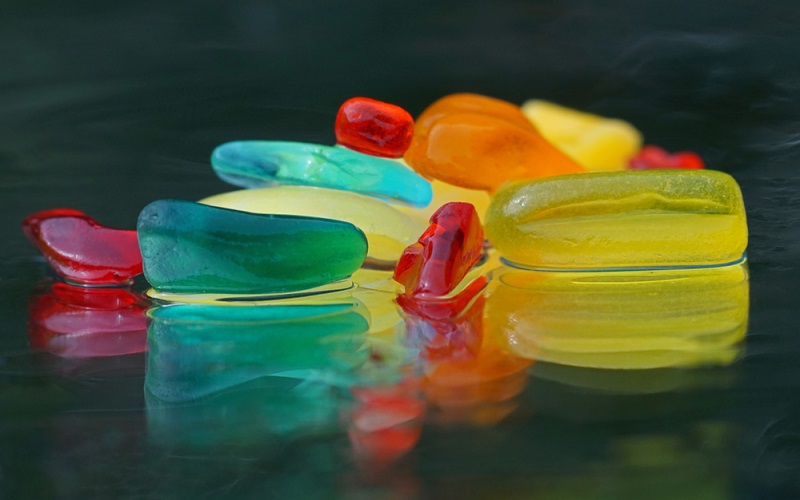
Sea glass colors are sometimes divided into four categories: ultra-rare, rare, more common, and most common. To some extent, the rarity of a certain color may be regionally influenced. But in a broad sense, there are certain colors that are only found limited amounts in any area of the world. These rare colors will always be more coveted by individual collectors and on the open market.
Ultra-rare
Orange and red are among the rarest sea glass finds. Yellow and teal also fall into this category, along with grays and blacks.
Studies have shown that orange is among people’s least favorite colors overall, so it’s not surprising that few glass items have been mass-produced in this color over the years. Because of this, orange is probably the rarest of sea glass pieces, found at a ratio of about one in 10,000 pieces.
Turquoise, or teal, has also rarely been mass-produced. Turquoise sea glass has an almost neon appearance and may sometimes still retain designs from the original decorative glass dishes it’s made from.
Red is considered the Holy Grail of sea glass by some collectors. It can make bright, striking jewelry pieces or stand out in any collection.
Yellow sea glass most often originates from glass bottles, but many also result from clear glass that turned pale yellow from a reaction of selenium found in the glass to the sun’s ultraviolet rays. This pale yellow is sometimes called “sun-colored” and is highly sought after by collectors.
Black glass is also highly valued by collectors. Black sea glass is not really black, but a very dark olive green or brown when held up to the light. Black glass liquor and beer bottles may date as far back as the 1700s, making this one of the most historically significant sea glass colors.
Most gray glass results from clear cut crystal to which lead oxide was added during the glass making process. This glass was manufactured from the 1800s to the 1940s. Various shades of sun coloring result from the glass’s exposure to ultra-violet rays. The darker the gray shade, the more valuable the piece.
Rare
Among the colors in the rare category are pink, purple (Amethyst color), aqua, and cobalt or cornflower shades of blue.
Pink was a popular color in depression-era glass. There are also various shades of sun-colored pink or peach sea glass. Aqua was an extremely popular color for many types of containers prior to the 1920s and can be light or dark. Amethyst shades are also sun-colored as a result of manganese added to the glass-making process in Germany from 1880-1915.
Cobalt and cornflower blue were commonly used for medicinal bottles in the 1880s and 1950s. Of the two, the lighter cornflower shade is rarer.
More Common
This category is also sometimes call “less rare.” Colors such as amber, sea green, and seafoam are included here.
Different amber shades come from whiskey, snuff, and bitters bottles dating as far back as the early 1900s.
Various shades of green sea glass date from the 1700s to the 1900s. Medicinal glass, tableware, and early soda bottles are common sources. Some shades, called “UV green,” are actually the result of trace amounts of uranium and have been known to glow in the dark!
Most Common
Kelly green, white, clear, and brown are the most common sea glass colors. Green glass has been manufactured prolifically for beer and soda bottles since the 1950s. White and brown have also been manufactured for many products in the last hundred years. Clear glass comes from many sources, including drinking glasses, windows, or windshields.
What Is Sea Glass Worth?
The recent popularity of genuine sea glass among collectors and the general public is making once prolific pieces harder and harder to find. Because of this, buyers are finding some prices skyrocketing, especially for the rarer colors. There are a number of ways to rate sea glass value, and the market continues to be refined.
Since less and less waste is being discarded in our oceans, it’s likely the shortage will only grow more acute as time passes. At the moment, the more common colors still have relatively little monetary value on their own. However, genuine sea glass can help increase the value of an artisan’s work in glass.
The rarer colors are a different story. A single piece of unset bright aqua genuine sea glass has sold for over $400. Pendant-size red, unset, may sell for over $100 each. Two earring-sized, pieces of blue sea glass have been sold for as high as $200 if nicely set, or a pair of red earrings for around $600.
Besides color, the value of individual pieces is rated by the quality of frost, thickness, shape, and uniqueness. Rare markings increase value, as they can add to the historicity of a piece.
Why Collect Sea Glass?
To some, sea glass may appear to be trash scattered among the more desirable shells and other flotsam on the beach. But there are a number of reasons why genuine sea glass has become desirable to collectors around the world.
Every piece of sea glass is unique, with a story to tell about its origins and past usefulness. These pieces cannot be artificially replicated. There is no substitute for the decades of tumbling in the vast salt oceans of the world.
Although originating from man-made materials, genuine sea glass is produced by nature without artificial shaping, alterations, coloring, or etching. It’s an eco-friendly recycling of trash into treasure. The smooth texture is pleasing to touch and the colors are pleasing to the eye.
Also, sea glass will more than likely continue to increase in value as supplies diminish. This makes it an investment for collectors as well as a motivation to take long walks along the beach.
Examples of What You Can Do With Sea Glass
Hobbyists and crafters have found a myriad of ways to turn sea glass into beautiful works of art. Pieces have been used to make jewelry of all kinds, including rings, necklaces, earrings, and bracelets.
The glass is also used in mosaic artwork. Possibilities are only limited by the imagination of the hobbyist. Colorful mobiles, shadow boxes, or mosaics between plates of glass catch the light and reveal the subtleties of individual pieces.
Some collectors would rather focus on the history behind the pieces, creating collections that give insight into local commerce and popular eras gone by. Others like to create chromatic displays that showcase the unending color variations produced by surf and sun.
However you choose to display or market your own sea glass, the fun is in the hunt. Whether your finds are close to home or those of a world traveler, sea glass can bring a collector a lifetime of adventure and enjoyment. Around the globe, the world’s past and future come together in a rainbow of color and hope. The earth continues to work to heal itself, and we will continue to do our part to help it do so.
- 7 Of The Largest Gold Nuggets Ever Found…Ever! - December 21, 2023
- Find Gold On Your Property? Here’s Why You Should Think Twice Before Spreading the News - December 21, 2023
- The Opalized Crab Claw (And How It Formed) - September 14, 2023
- Online rock and mineral club for collectors of all levels!
- Find community with like-minded rock and mineral enthusiasts.
- Monthly Giveaways!
- Free Access to Entire Digital Library of Products (annual memberships)

